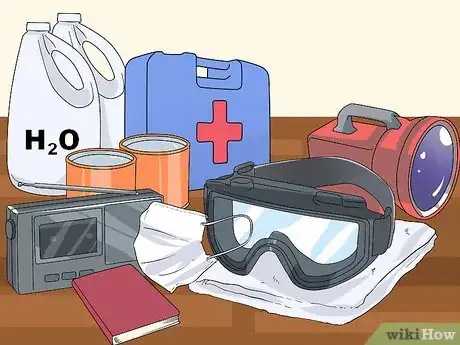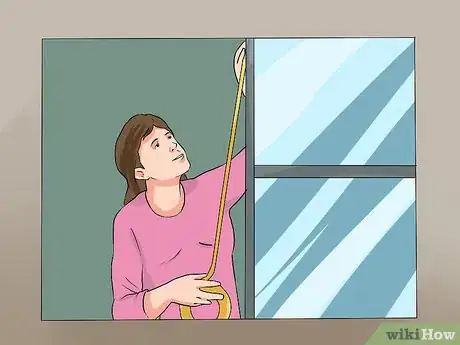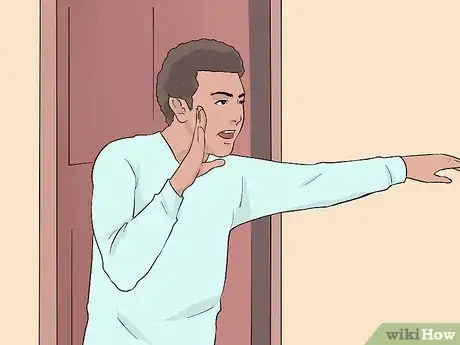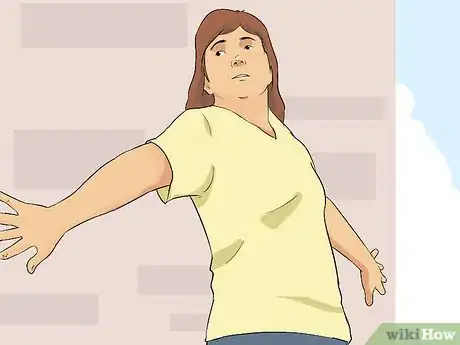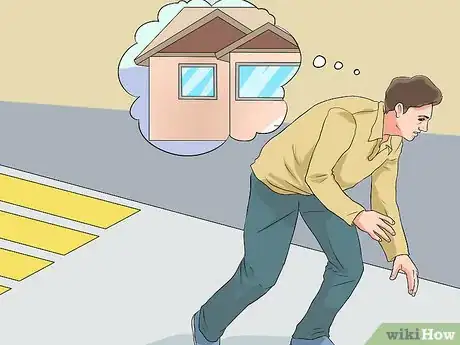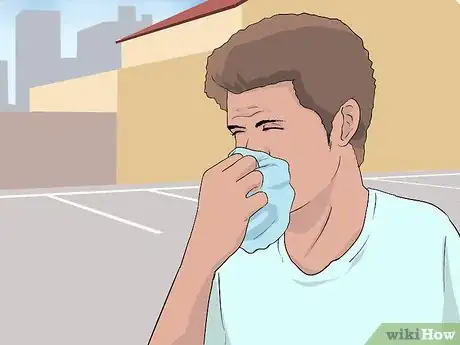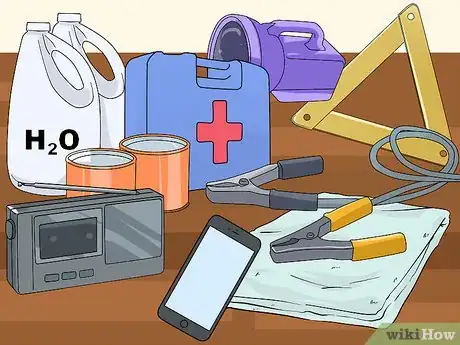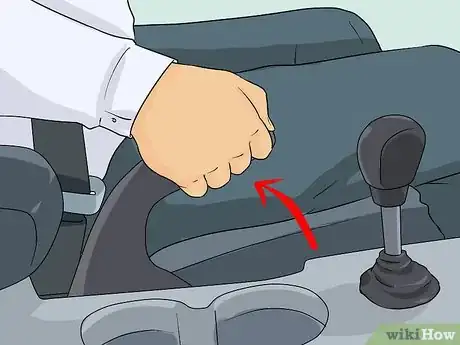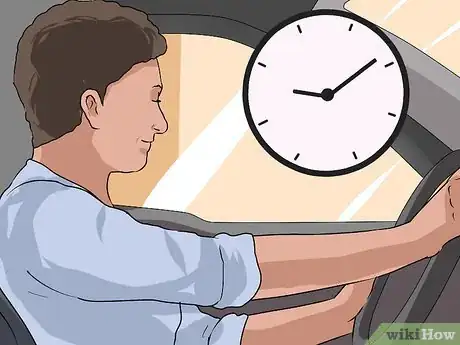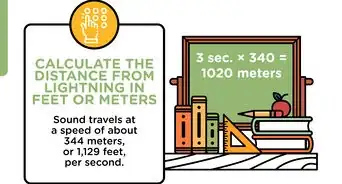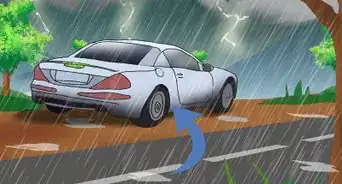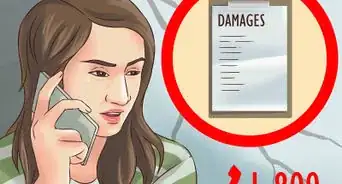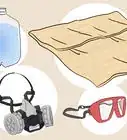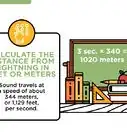This article was co-authored by wikiHow Staff. Our trained team of editors and researchers validate articles for accuracy and comprehensiveness. wikiHow's Content Management Team carefully monitors the work from our editorial staff to ensure that each article is backed by trusted research and meets our high quality standards.
wikiHow marks an article as reader-approved once it receives enough positive feedback. In this case, 80% of readers who voted found the article helpful, earning it our reader-approved status.
This article has been viewed 40,436 times.
Learn more...
Dust storms are a relatively common occurrence in a variety of places around the world. They consist of large amounts of dirt and dust that are whipped up into the air by strong winds blowing across dry ground.[1] These storms can be very large but usually do not last for very long. Because of the dangers associated with these storms, most notably the danger to breathing that they cause, it's important to prepare for them so that you can survive them more easily.
Steps
Preparing at Home
-
1Make a dust storm survival kit. You can store most of the smaller items in a box, but a backpack or a bag would be better. When collecting items for your kit, remember that the most important things in a dust storm are fresh water, food, clean air, and warmth. Unlike a general emergency kit, the breathing protections are really key. Thus, some items you should include are:[2]
- A facemask or dense cotton fabric (to protect your breathing)
- Airtight goggles (to keep dust out of the eyes)
- Non-perishable food
- Filled water bottles (3 gallons of water per person)
- First aid kit
- A blanket or heavy clothes
- Self powered weather radio
- Flashlight and extra batteries
- A list of items to collect from your home (this could include prescription medications and important papers)
-
2Place your survival kit is an easily accessible location. You need to be able to access your emergency supplies quickly when you get a storm warning or the storm hits. This means that your emergency supplies should be stored in a place that you can get to without a lot of trouble. For example, you could put them in a designated spot in your basement, pantry, or garage.
- It's a good idea to place your emergency supplies in the space you will go to in an emergency. That way you will not need to move them in order to have access to them when taking shelter.
Advertisement -
3Make sure your home is well sealed. Dust from a dust storm can invade your home, making it difficult to breathe even when inside. In order to avoid this if your area is prone to dust storms, make sure your house is well sealed before a storm even hits.
- Check door and window seals. Make sure they are not damaged and provide a good seal.
- Know how to block off all your vents. This could be under-house vents or air-intake vents for your HVAC system.
-
4Get storm updates. Turn on weather radios or go online and check for alerts and warnings. Be aware, though, that most dust storms come without any warnings or signs. This is why it is so important to be prepared for them if you live in an area that have them.
- If no warnings or alerts are there, don't think your city is safe from dust storms.
-
5Heed warnings. If you suspect a dust storm is developing, then it is important to get your family inside. Hopefully this will be into your house, where you have your emergency supplies, but it may not be. If a storm is really happening, find the closest building to you and go inside. Taking cover from a developing storm is the best way to prepare for the storm.
- Make sure that your pets stay indoors during a dust storm as well. If you have animals that can't come in your home, for instance animals that live in barns, try to protect them from the storm as best you can by making sure they have shelter.
Preparing If You Are Outside
-
1Get inside if you can. Don't stay outdoors during a dust storm intentionally. If hear a dust storm warning don't ignore it. If you have any way to get inside a building, do it quickly.
- Well-sealed buildings are ideal but any structures that will withstand the storm and give you some protection are best.
-
2Take shelter. If you cannot get inside a building or a car, find a location that is relatively protected from the storm. This could be against the side of a building or under a piece of vegetation, whatever you can find. Just be sure to stay off roads and out of areas that may be more dangerous than helpful.
- Avoid laying in ditches or dry riverbeds for protection. Dust storms are often followed by thunderstorms, so you protected area may quickly become a spot for flash flooding.
-
3Find protective materials. Most importantly, find something to protect your breathing. If you cannot get inside, find something to breathe through before the storm hits. Ideally this would be a particulate filter mask but any dust mask or thick piece of clothing will suffice.
- Cloth will not keep all particulates out of your respiratory system, but it is better than nothing. It will help to keep large particulates out and will help you get the oxygen you need to breathe and survive.
- Although you shouldn't, if you are determined to go outside in a severe dust storm, then you should wear a particulate filter mask and airtight goggles to protect your mouth, nose, and eyes. This will help to assure that you do not inhale the dust, which is dangerous for your health and can cause serious breathing problems and even death.[3]
-
4Cover your eyes, nose, and mouth. Before the storm actually hits, or as soon as possible, you should cover up your face. This will allow you to keep breathing and to avoid damage to your eyes.[4]
- In addition, if you have a hat or piece of clothing that you can cover your ears with, do that. Dust from a dust storm can easily get in your ears and clog them. However, don't protect your ears over protecting your eyes, nose, and mouth.
Preparing If You Are in a Vehicle
-
1Make a car emergency kit. A car dust storm emergency kit will not be as comprehensive as a home kit but it will be very important if you are caught out in a storm. A car emergency kit that will help you through a dust storm should include:[5]
- Jumper cables
- Flares or reflective triangle
- Flashlight with extra batteries
- First aid kit
- Non-perishable food (such as protein rich energy bars)
- Water
- Basic toolkit (pliers, wrench, screwdriver)
- Radio (battery or hand cranked)
- Blankets or sleeping bags (or simply extra layers of clothes)
- Charged cell phone and car charger
-
2Stop driving. It is not safe to drive in a large dust storm. Instead of continuing to drive in the storm, find a close spot to park that is as protected as possible. Pull off the road as far as possible, turn off your car, and make sure your windows are all closed.
- If you are not in a spot that you can pull off, make sure your lights are on, honk your horn continuously, and use the center lane line as a guide. Do this until you can find a place to pull off the road.
-
3Turn your car lights off. While it seems like a good idea to show other vehicles where you are located by turning your lights on, it's not. Drivers coming from behind may think that you are on the road and your lights will actually lead them off of it.
- Instead of leaving your lights on, just make sure your car is totally off the road. This will protect you better and will help to protect the safety of other drivers.
-
4Seal your car up. Make sure all windows and doors are closed as soon as you can. In a big dust storm, dust may get into your car through the vents, so it's also important to close them all as well.[6]
- In a really severe storm, with strong winds, you may even need to place a piece of fabric or tape over the vents so that dust doesn't seep into the car. The goal is to keep dust out as much as you can.
-
5Wait the storm out. Most dust storms are very brief. It is a good idea to wait the storm out instead of getting jumpy and trying to change locations. The odds are that you will be stuck in your car for a very short time and it is much better to be in the car than to be out in the storm.
Community Q&A
-
QuestionWhat should I do after the dust storm?
 Community AnswerDon't uproot crops until you need to plant new crops. Have an emergency bag of supplies ready for when the next storm comes.
Community AnswerDon't uproot crops until you need to plant new crops. Have an emergency bag of supplies ready for when the next storm comes. -
QuestionShould I do more than not uprooting crops after a dust storm?
 Community AnswerYes, you should clean up what you can before another sand storm hits. Also, take steps to be ready for another sand storm.
Community AnswerYes, you should clean up what you can before another sand storm hits. Also, take steps to be ready for another sand storm.
Warnings
- Dust storms don't just happen in a desert. They can happen wherever loose sand or dirt can be whipped up into the air.[7]⧼thumbs_response⧽
References
- ↑ https://weather.com/science/nature/news/arizona-new-mexico-california-southwest-dust-storms-20131031
- ↑ http://www.justincasearizona.com/make-a-kit.asp
- ↑ https://www.unisdr.org/archive/45756
- ↑ http://www.justincasearizona.com/be-informed/natural-disasters/dust-storms.asp
- ↑ https://www.ready.gov/car
- ↑ https://blog.allstate.com/tips-for-staying-safe-during-a-haboob/
- ↑ https://weather.com/science/nature/news/arizona-new-mexico-california-southwest-dust-storms-20131031
